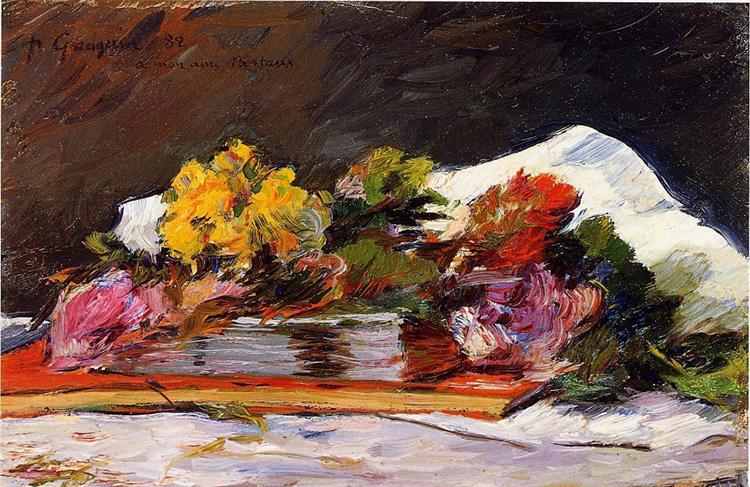תיאור
Paul Gauguin's painting "Bouquet of Flowers" (1882) is a work that encapsulates an early stage of his career, before the artist delved into the bolder explorations that would define his legacy. In this piece, the depiction of a lush bouquet of flowers becomes a celebration of form and color, elements that Gauguin would later transition into through his distinctive personal style. At first glance, the painting presents us with a vibrant display of flowers, arranged in a setting that seems almost intimate and domestic, reflecting the artist's relationship with nature and his appreciation for ephemeral beauty.
The work is composed of a series of hues that mix warm and cool tones. The flower petals are displayed in a variety of colors, including pinks, yellows, oranges and purples, creating a visual effect that is both resplendent and harmonious. The palette Gauguin uses reveals his ability to operate within color, a theme that would become fundamental to his later interest in symbolism and chromatic experimentation. Here we already see the traits that would characterize his unique style, although the work still retains a rootedness in Impressionism, a style from which he was partly heir.
The composition of "Bouquet of Flowers" is inherently simple, allowing the viewer to focus on the very nature of the flowers. The way the different plant species are arranged and superimposed suggests an almost sculptural approach; Gauguin manages to give life and volume to the flowers, making them stand out from the surface of the canvas. There are no human characters in this work, which leads one to consider that the focus is entirely on nature, marking a distance from the narrative usually present in many works by his contemporaries.
It is interesting to note that this work is set within the context of a Europe that was in the midst of an aesthetic shift. In the late 19th century, artists were beginning to deconstruct the traditions of realism and academicism in search of freer, more subjective expressions. Gauguin, in particular, was beginning to experiment with form and colour as vehicles of emotion and symbol, which would be deepened in his quest for an art that transcended mere representation.
This painting aligns with other works of the period that approach nature in diverse ways. Artists such as Claude Monet also explored plant life, but with a more impressionistic approach, which contrasts with the more structured and visceral representation proposed by Gauguin. The search for symbolism in "Bouquet of Flowers" is a precursor to what would develop in his later works, where the flower would become a symbol of beauty and transience, viewed through a more emotional prism.
In short, “Bouquet of Flowers” is a testament to Paul Gauguin’s nascent talent and an example of his ability to capture the essence of nature through a masterful combination of color and form. In this work, rather than telling a traditional story, the artist invites the viewer to linger on the pure beauty of the moment, unified in every stroke. As this work is examined closely, it reveals itself not only as a painting of flowers, but as a prelude to the bold explorations that Gauguin would undertake in the years to come.
KUADROS ©, a famous painting on your wall.
Hand-made oil painting reproductions, with the quality of professional artists and the distinctive seal of KUADROS ©.
Painting reproduction service with satisfaction guarantee. If you are not completely satisfied with the replica of your painting, we will refund 100% of your money.

